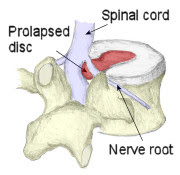Sciatica is not a condition as such, but a symptom which can be caused by numerous conditions. The common sciatica symptoms involve pain that starts in the back and radiates down one (or both) of the legs. It is quite a common complaint and sciatica pain is caused by pressure on the sciatic nerve which runs down into the leg. The medical term is acute nerve root compression or radiculopathy.
- Acute low back pain (not always present, especially in piriformis syndrome)
- Pain radiating down the leg. This pain may be sharp and accompanied by pins and needles and / or numbness
- Sciatica pain is often triggered by a minor movement such bending over to pick something up
- Pain may be worse by sitting, lifting, coughing or sneezing
- Pain is usually relieved by lying down, often on one side
- Pain is often better in the morning after a nights rest
- There may be muscle spasm in the lower back
- Tenderness in the lower back when pressing in
- Pain on the straight leg raise test (video) which is not apparent when just stretching the hamstring only
- Rest in bed if necessary in a position that is comfortable
- A doctor may prescribe NSAID's (non steroidal anti inflammatory drugs) such as ibuprofen. Should always be taken under the direction of a doctor and not if the patient has asthma
- Apply heat or a hot bath may help to relieve muscle spasm
- Use of a heat retainer or back brace can provide support in the early stages
- See a sports injury specialist or doctor
- Begin extension exercises as soon as pain allows
- Prescribe anti-inflammatory medication e.g. ibuprofen or muscle relaxants
- Use sports massage techniques to relax tight muscles
- Gently apply mobilization techniques to the spine
- Use traction or advise on the use of and Inversion Table
- Apply electrical stimulation in the form of a Tens machine or Interferential
- Apply ultrasound treatment
- Performa a simple operation called a discectomy on a slipped disk if neurological signs (nerve related symptoms) continue or worsen
- After the acute painful phase
- Restore pain free movement to the back through mobilization and stretching techniques
- Ensure posture and correct lifting techniques are learned and maintained
- Strengthen the core stabilizing muscles of the spine
Resource from: http://www.sportsinjuryclinic.net



Thank you Kerry :)
ReplyDeleteHappy New Year 2010 and best of of luck!
I do have this problem. It happened around 4 yrs back. But yesterday i did bend to keep my laptop down and sudenly was not able to get up anymore due to acute pain in the lower back. I am now bedridden. Can you suggest me what do i do. Any names and numbers of good doctors whom I can contact. I am based out of KL (Sentral).
ReplyDeleteRgds, Ranajit (ranjit_ch@hotmail.com)
ranjit_ch@hotmail.com
ReplyDeleteu may want to try tis old "sifu in sri petaling Tel 013-8540209.
Kindly inform me of yr treatment if u ever go there. tq from tommy_teh@yahoo.com